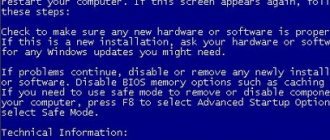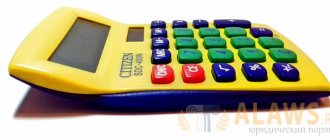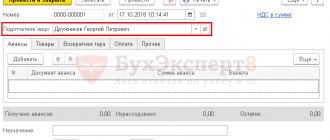Manufactured and purchased printing products are included in inventories.
When advertising printed products are distributed free of charge, their actual cost is written off as expenses for ordinary activities. When reselling printed products, income from ordinary activities is recognized in the amount of the sale price of such goods, and its actual cost is included in the cost of sales of the current reporting period. The costs of producing business letterheads and business cards are written off as expenses for ordinary activities of the organization when such printed products are transferred to employees for their use.The cost of binding, photocopying, and typing used in carrying out operations that are the subject of the organization's activities is recognized as part of the organization's expenses for ordinary activities as administrative expenses.
Reflection in accounting of expenses for printing services and products depends on the purpose of their further use, in particular - for advertising, resale or for management purposes. Let's consider several options.
Standard postings in budgetary institutions
Accounting for seals in budget departments is much more difficult than in ordinary departments. Initially, a decision is made on which item needs to be reflected: 310 (if the seals will be used for more than a year) or 340 (use period less than 1 year).
Based on Instruction No. 157n, an object that has been used for more than a year is recorded as a fixed asset, regardless of its price. When the print has been used for less than a year. If the useful life is less than a year, then the seals are classified as inventories. The decision on this is made by the commission.
- If the acceptance was carried out as a fixed asset. The postings indicate the cost of all costs, including VAT. If it is less than 3 thousand rubles, then it is written off from the account and simultaneously reflected on it in 21 “Fixed assets worth up to 3 thousand rubles inclusive in operation.”
- When assigning a seal to the category “Material reserves”. If a decision is made to include them as inventory, then assignment to them occurs on the basis of the following documents:
- waybill;
- invoices;
- waybill;
- act of acceptance of the established form (0315004).
Printed products intended for resale
When reselling printed products, the organization recognizes income from ordinary activities in the amount of the sale price of such goods (clauses 5, 6, 6.1, 12 of the Accounting Regulations “Organizational Income” PBU 9/99, approved by Order of the Ministry of Finance of Russia dated May 6, 1999 N 32n). At the same time, the actual cost of this product is included in the cost of sales of the current reporting period (clauses 5, 7, 9, 16, 18, 19 PBU 10/99).
The amount of VAT presented by the manufacturer of printed products is accepted for deduction in full in the generally established manner on the basis of an invoice issued in accordance with the requirements of tax legislation, after it has been registered and in the presence of the relevant primary documents (clause 2 of Article 169, paragraph 1, paragraph 2, article 171, paragraph 1, article 172 of the Tax Code of the Russian Federation, Letter of the Ministry of Finance of Russia dated October 17, 2016 N 03-03-06/2/60252).
The following entries are made in accounting (Instructions for using the Chart of Accounts):
- debit 41 credit 60 - printed products were accepted for accounting on the basis of the manufacturer’s shipping documents and the receipt order;
- debit 19 credit 68 - VAT presented by the manufacturer of printed products is reflected based on the invoice;
- debit 68 credit 19 - accepted for VAT deduction based on the invoice;
- debit 60 credit 51 - payment was made for manufactured printing products based on a bank statement on the current account;
- debit 62 credit 90-1 - income from the resale of printed products is recognized on the basis of the invoice;
- debit 90-2 credit 68 - VAT is charged on the cost of printed products;
- debit 90-2 credit 41 - the actual cost of printing products is written off based on the accounting reference and calculation.
How to fill out the register of seals and stamps
All seals and stamps must be strictly taken into account. There is a special magazine for this. It contains their imprints and information about which department they were transferred to, with the signature of the responsible persons. The journal contains 8 columns:
| No. | Name of seal/stamp | Imprint | Issue for use | Return | Note | |||
| position and full name of the recipient | signature, date of receipt | position and full name of the recipient | signature, date of receipt | |||||
| 1 | 2 | 3 | 4 | 5 | 6 | 7 | 8 | |
- The first column indicates the serial number.
- In the “Name of the seal” column, its purpose is indicated, for example, “Stamp for documents”.
- In the third column, a print is required; it must be clear and not blurry.
- Column No. 4 indicates, for example: “sales manager Kovalenko A.M.”
- In column 5 - the signature of the responsible person indicating the date of receipt.
- Columns 6-7 are filled in similarly to columns No. 4 and 5, only in case of a return.
- The “Note” line is filled in if the seal is destroyed, indicating the act number and date of preparation.
The journal must be filled out in handwritten form, since it requires the original signature of the responsible persons. The names of the columns may change depending on the needs and activities of the organization. There is no strictly established form of the Journal. The form is not regulated by law.
Despite this, it must be conducted in compliance with all strict reporting requirements:
- Sequential numbering of pages is required;
- the magazine must be laced;
- the document is stamped and signed by the director;
- The magazine is kept in an iron safe.
The legislation does not require the presence of columns in the Journal. The organization has the right to adjust them, depending on its activities.
Business forms and individual business cards
Business forms are used by employees of an organization to conduct business correspondence and contain the organization’s logo, its location, contact numbers and the organization’s website.
A business card is a business card that contains official information about the employee (his full name, position, telephone number, email address, name, address and website of the organization in which he works). The organization's logo can also be placed on the business card.
Manufactured business forms and business cards are accepted for accounting as part of inventories at the actual cost, determined on the basis of the amount paid to the printing organization for their production (excluding VAT) and are reflected as an entry in the debit of account 10 in correspondence with the credit of account 60 (p 2, 5, 6 PBU 5/01, Instructions for using the Chart of Accounts).
Costs for the production of business forms and business cards are written off as expenses for ordinary activities of the organization using accounts 26 or 44 (clauses 5, 6, 16 of PBU 10/99). Write-off is carried out upon transfer of such printed products to the employees using them, on the basis of the invoice requirement (clause 93 of the Guidelines for accounting of inventories, approved by Order of the Ministry of Finance of Russia dated December 28, 2001 N 119n).
If an organization has the right to maintain simplified accounting, it can write off business forms and business cards as expenses for ordinary activities in the full amount immediately at the time of purchase (clause 13.3 PBU 5/01, Information message of the Ministry of Finance of Russia dated June 24, 2016 N IS-accounting 5). In this case, when transferring business forms and business cards to the employees using them, no entries need to be made. The following entries are made in accounting (Instructions for using the Chart of Accounts):
- debit 10 credit 60 - manufactured business forms (business cards) are accepted for accounting based on the manufacturer’s shipping documents;
- debit 19 credit 68 - VAT presented by the manufacturer of forms (business cards) is reflected based on the invoice;
- debit 68 credit 19 - accepted for VAT deduction based on the invoice;
- debit 60 credit 51 - payment was made for manufactured business forms (business cards) based on the bank statement of the current account;
- debit 26, 44 credit 10 - the cost of used business forms (business cards) is written off based on the invoice request.
Storage of seals and stamps in the organization
The method of storing seals and stamps depends on their type and purpose. The round seal (main) is located in a safe, to which only the head of the organization has access. In case of his long absence, it is handed over to the responsible employee against signature.
Auxiliary seals and address stamps are kept by responsible employees who use them to perform daily work. It is also stored in sealed metal cabinets, to which a certain circle of people have access. Stamps must be in sliding drawers.
Results
Writing off and destroying a seal is not particularly difficult.
The company should do this both in the case when the previous seal is no longer relevant, and in the case when the seal has become unusable. The company may destroy the seal itself or entrust this to a third party that specializes in providing such services. You can find more complete information on the topic in ConsultantPlus. Free trial access to the system for 2 days.
Checking the condition of seals and stamps
The procedure can be planned, or it can be carried out if there is suspicion of the use of a counterfeit seal. In any of the above cases, a special commission is assembled. Based on the results of the inspection, a report is drawn up and submitted to the head of the organization. It outlines identified problems, shortcomings and recommendations for eliminating them.
When dismissing an employee, the general director sends a commission to establish the fact of the presence of seals, as well as to establish their authenticity. Based on the results, an acceptance and transfer act is drawn up, with which the new employee must be familiarized. An experienced expert can even identify the authenticity of a seal visually; if suspicions arise, then to confirm them, the subject of research is sent to the laboratory.
How to replace seals
To introduce a new seal on an organization, it is necessary to destroy the old one. The following options exist:
| Disposal in-house | Seeking help from a specialized stamp organization |
| Produced by a specially appointed commission | The stamp is submitted to a third-party stamp organization |
After execution of the order, an act is drawn up indicating the following data:
| Along with the seal, a set of documents is provided:
|
When recycling on your own, the act must be kept throughout the entire duration of the organization’s activities in order to avoid controversial disputes. If the seal is lost, the recycling procedure will not be possible. To obtain a new print, you must provide the above set of documents along with a certificate from internal affairs, which establishes the fact of the loss.
It is also necessary to notify the registration authority about the theft and submit advertisements in the media. It is imperative to report the incident to the bank where the company's current account is opened in order to prevent the withdrawal of funds from the current account. The company chooses the disposal method itself
OSNO and UTII
If an organization applies a general taxation system and pays UTII, and uses purchased stationery in both types of activities, then the cost of these stationery must be distributed (clause 9 of Article 274 of the Tax Code of the Russian Federation).
The amount of VAT allocated in the invoice for the purchase of stationery also needs to be distributed. Distribute VAT according to the methodology established in paragraphs 4 and 4.1 of Article 170 of the Tax Code of the Russian Federation.
The amount of VAT that cannot be deducted should be added to the share of expenses for the organization’s activities subject to UTII (subclause 3, clause 2, article 170 of the Tax Code of the Russian Federation).
Key points on control of seals and stamps
Organizations were always required to have round seals, which necessarily contained information about the name of the company and its address. Federal Law No. 82 FZ speaks not about the obligation, but about the right to have such a seal.
It follows from the same law that information about seals must be contained in the charter. Despite the fact that the law does not prescribe the mandatory presence of a seal, the company’s activities without it are simply impossible. It is required:
- upon acceptance (if this is the first place of employment) and dismissal of an employee;
- when submitting documents to the tax authorities (certified copies, declarations on paper);
- submission of reports to the Social Insurance Fund and the Pension Fund of Russia;
- preparation of internal personnel documentation, writing letters and much more.
simplified tax system
If an organization pays a single tax on income, then when calculating the tax base, do not take into account the cost of stationery (clause 1 of Article 346.14 of the Tax Code of the Russian Federation).
If an organization pays a single tax on the difference between income and expenses, the cost of stationery reduces the tax base (subclause 17, clause 1 and clause 2, article 346.16, subclause 22, clause 1, article 264 of the Tax Code of the Russian Federation). You can take into account the costs of purchasing stationery immediately after paying for them (Clause 2 of Article 346.17 of the Tax Code of the Russian Federation).
Advice: to avoid disputes with inspectors, take into account the cost of stationery in the costs when calculating the single tax at the time of their transfer to the departments.
When including costs in the tax base, they must be economically justified, documented and related to activities aimed at generating income (clause 1 of Article 252, clause 2 of Article 346.16 of the Tax Code of the Russian Federation).
If an organization recognizes expenses for the purchase of office supplies that have been posted to the warehouse, but have not yet been written off to departments, inspectors can challenge them (as expenses not related to activities aimed at generating income). To avoid this, charge the cost of stationery to expenses only after they have been issued for use in activities (upon request-invoice in form No. M-11 or act (report)).
Also include input VAT on purchased stationery as expenses (subclause 8, clause 1, article 346.16 of the Tax Code of the Russian Federation).
Answers to common questions
Question No. 1. Do I need to register a new seal?
Mandatory registration has been cancelled, you can do this if you wish to assign a registration number.
Question No. 2. Can I use logos and graphics in prints?
This is not prohibited if it does not constitute unfair competition and hidden advertising of the organization.
Question No. 3. Is it necessary to destroy the seal when reorganizing a company?
No, it is not necessary, but it is better to recycle it to avoid questions.
Question No. 4. What is the difference between a seal and a stamp?
The stamp does not have legal force, but serves to facilitate work.
Question No. 5. Is the accounting of seals different in private and budgetary organizations?
Yes, the chart of accounts in a budget organization is completely different, and accordingly, the accounting of seals is very different.
Decoding KOSGU 310 from 2021
In 2021, a new Procedure for the application of KOSGU comes into force by order of the Ministry of Finance No. 209n.
Let's consider how to now attribute expenses under article KOSGU 310 and how to distinguish fixed assets from inventories.
According to the provisions of Order No. 209n, Article 300 groups business transactions related to the creation or acquisition of non-financial assets. Read more about the new procedure for applying KOSGU from 2021. Property classification is carried out by fixed assets; biological, non-produced or intangible assets; material stocks; non-exclusive rights or rights of use.
The requirements are the same for budgetary institutions of all levels. Article 310 of KOSGU decoding 2021 means an increase in the cost of the organization's fixed assets.
According to clause 11.1 of Order No. 209n, this includes the following costs of the institution associated with fixed assets:
- To pay for municipal or government contracts.
- Under contracts for the purchase (production or construction) of objects.
- In terms of contracts for modernization, reconstruction, expansion, technical re-equipment, additional equipment of existing facilities in the organization.





